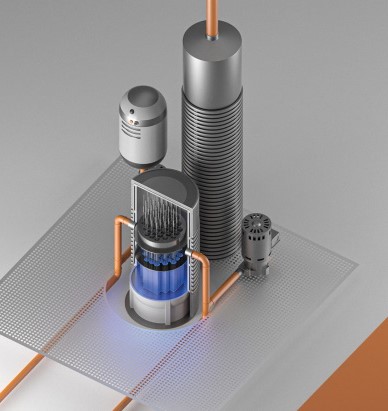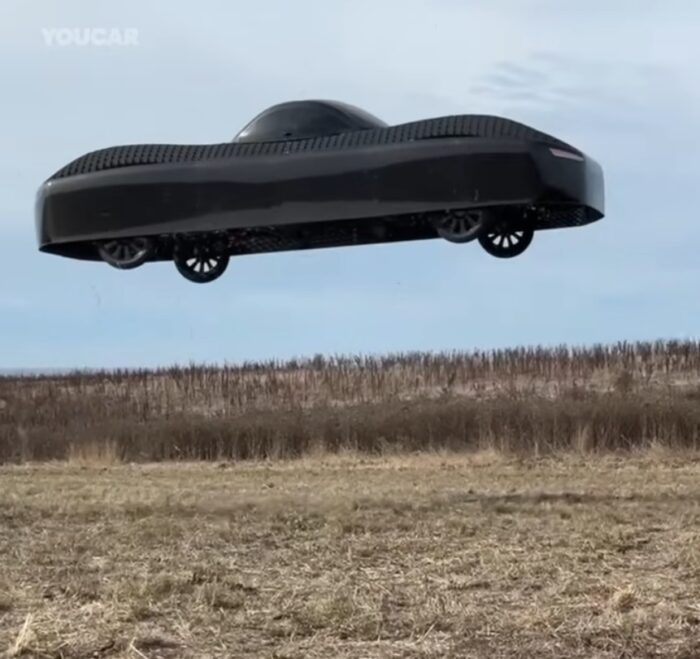Feb
27
2025
 Small nuclear reactors have been around since the 1950s. They mostly have been used in military ships, like aircraft carriers and submarines. They have the specific advantage that such ships could remain at sea for long periods of time without needing to refuel. But small modular reactors have never taken off as a source of grid energy. The prevailing opinion for why this is seems to be that they are simply not cost effective. Larger reactors, which are already expensive endeavors, produce more megawatts per dollar. SMRs are simply too cost inefficient.
Small nuclear reactors have been around since the 1950s. They mostly have been used in military ships, like aircraft carriers and submarines. They have the specific advantage that such ships could remain at sea for long periods of time without needing to refuel. But small modular reactors have never taken off as a source of grid energy. The prevailing opinion for why this is seems to be that they are simply not cost effective. Larger reactors, which are already expensive endeavors, produce more megawatts per dollar. SMRs are simply too cost inefficient.
This is unfortunate because they have a lot of advantages. Their initial investment is smaller, even though the cost per unit energy is more. They are safe and reliable. They have a small footprint. And they are scalable. The military uses them because the strategic advantages are worth the higher cost. Some argue that the zero carbon on demand energy they provide is worth the higher cost, and I think this is a solid argument. Also there are continued attempts to develop the technology to bring down the cost. Arguably it may be worth subsidizing the SMR industry so that the technology can be developed to greater cost effectiveness. Decarbonizing the energy sector is worth the investment.
But there is another question – are there civilian applications that would also justify the higher cost per unit energy? I have recently encountered two that are interesting. The first is a direct extension of the military use – using an SMR to power a cargo ship. South Korean company, HD Korea Shipbuilding & Offshore Engineering, has revealed their designs for an SMR powered cargo ship, and has received “approval in principle”. Obviously this is just the beginning phase – they need to actually develop the design and get full approval. But the concept is compelling.
Continue Reading »
Feb
24
2025
 The flying car is an icon of futuristic technology – in more ways than one. This is partly why I can’t resist a good flying car story. I was recently sent this YouTube video on the Alef flying car. The company says his is a street-legal flying car, with vertical take off and landing. They also demonstrate that they have tested this vehicle in urban environments. They are available now for pre-order (estimated price, $300k). The company claims: “Alef will deliver a safe, affordable vehicle to transform your everyday commute.” The claim sounds reminiscent of claims made for the Segway (which recently went defunct).
The flying car is an icon of futuristic technology – in more ways than one. This is partly why I can’t resist a good flying car story. I was recently sent this YouTube video on the Alef flying car. The company says his is a street-legal flying car, with vertical take off and landing. They also demonstrate that they have tested this vehicle in urban environments. They are available now for pre-order (estimated price, $300k). The company claims: “Alef will deliver a safe, affordable vehicle to transform your everyday commute.” The claim sounds reminiscent of claims made for the Segway (which recently went defunct).
The flying car has a long history as a promise of future technology. As a technology buff, nerd, and sci-fi fan, I have been fascinated with them my entire life. I have also seen countless prototype flying cars come and go, an endless progression of overhyped promises that have never delivered. I try not to let this make my cynical – but I am cautious and skeptical. I even wrote an entire book about the foibles of predicting future technology, in which flying cars featured prominently.
So of course I met the claims for the Alef flying car with a fair degree of skepticism – which has proven entirely justified. First I will say that the Alef flying car does appear to function as a car and can fly like a drone. But I immediately noticed in the video that as a car, it does not go terribly fast. You have to do some digging, but I found the technical specs which say that it has a maximum road speed of 25 MPH. It also claims a road range of 200 miles, and an air range of 110 miles. It is an EV with a gas motor to extend battery life in flight, with eight electric motors and eight propellers. It is also single passenger. It’s basically a drone with a frame shaped like a car with tires and weak motors – a drone that can taxi on roads.
It’s a good illustration of the inherent hurdles to a fully-realized flying car of our dreams, mostly rooted in the laws of physics. But before I go there, as is, can this be a useful vehicle? I suppose, for very specific applications. It is being marketed as a commuter car, which makes sense, as it is single passenger (this is no family car). The limited range also makes it suited to commuting (average daily commutes in the US is around 42 miles).
Continue Reading »
Feb
21
2025
 I am fascinated by the technologies that live largely behind the scenes. These are not generally consumer devices, but they may be components of consumer products, or may largely have a role in industry – but they make our modern world possible, or make it much better. In addition I think that material science is largely underrated in terms of popular appeal, but it is material science that often make all other technologies possible or feasible. There is another aspect of technology that I have been increasingly interested in – solid state technology. These are, generally speaking, devices that use electricity rather than moving parts. You are likely familiar with solid state drives, that do not have spinning discs and therefore are smaller, use less power, and last longer. One big advantage of electric vehicles is that they are largely solid state, without the moving parts of an engine.
I am fascinated by the technologies that live largely behind the scenes. These are not generally consumer devices, but they may be components of consumer products, or may largely have a role in industry – but they make our modern world possible, or make it much better. In addition I think that material science is largely underrated in terms of popular appeal, but it is material science that often make all other technologies possible or feasible. There is another aspect of technology that I have been increasingly interested in – solid state technology. These are, generally speaking, devices that use electricity rather than moving parts. You are likely familiar with solid state drives, that do not have spinning discs and therefore are smaller, use less power, and last longer. One big advantage of electric vehicles is that they are largely solid state, without the moving parts of an engine.
There is a technology that combines all three of these features – it is a component technology, dependent on material science, and solid state: thermoelectric devices. This may not sound sexy, but bear with me, this is cool (pun intended) technology. Thermoelectric materials are those that convert electricity into a temperature difference across a material, or convert a temperature difference into electricity. In reality, everything is a thermoelectric material, but most materials have insignificant thermoelectric effects (so are functionally not thermoelectric).
Thermoelectric devices can be used to harvest energy, from any temperature difference. These are generally not large amounts of energy – we don’t have thermoelectric power plants connected to the grid – and they are currently not practical and cost effective enough for a large scale. This may be possible in the future, but not today. However, for applications that require small amounts of energy, harvesting that energy from ambient sources like small temperature differences is feasible.
Continue Reading »
Feb
18
2025
 The evolution of the human brain is a fascinating subject. The brain is arguably the most complex structure in the known (to us) universe, and is the feature that makes humanity unique and has allowed us to dominate (for good or ill) the fate of this planet. But of course we are but a twig on a vast evolutionary tree, replete with complex brains. From a human-centric perspective, the closer groups are to humans evolutionarily, the more complex their brains (generally speaking). Apes are the most “encephalized” among primates, as are the primates among mammals, and the mammals among vertebrates. This makes evolutionary sense – that the biggest and most complex brains would evolve from the group with the biggest and most complex brains.
The evolution of the human brain is a fascinating subject. The brain is arguably the most complex structure in the known (to us) universe, and is the feature that makes humanity unique and has allowed us to dominate (for good or ill) the fate of this planet. But of course we are but a twig on a vast evolutionary tree, replete with complex brains. From a human-centric perspective, the closer groups are to humans evolutionarily, the more complex their brains (generally speaking). Apes are the most “encephalized” among primates, as are the primates among mammals, and the mammals among vertebrates. This makes evolutionary sense – that the biggest and most complex brains would evolve from the group with the biggest and most complex brains.
But this evolutionary perspective can be tricky. We can’t confuse looking back through evolutionary time with looking across the landscape of extant species. Any species alive today has just as much evolutionary history behind them as humans. Their brains did not stop evolving once their branch split off from the one that lead to humans. There are therefore some groups which have complex brains because they are evolutionarily close to humans, and their brains have a lot of homology with humans. But there are also other groups that have complex brains because they evolved them completely independently, after their group split from ours. Cetaceans such as whales and dolphins come to mind. They have big brains, but their brains are organized somewhat differently from primates.
Another group that is often considered to be highly intelligent, independent from primates, is birds. Birds are still vertebrates, and in fact they are amniotes, the group that contains reptiles, birds, and mammals. It is still an open question as to exactly how much of the human brain architecture was present at the last common ancestor of all amniotes (and is therefore homologous) and how much evolved later independently. To explore this question we need to look at not only the anatomy of brains and the networks within them, but brain cell types and their genetic origins. For example, even structures that currently look very different can retain evidence of common ancestry if they are built with the same genes. Or – structures that look similar may be built with different genes, and are therefore evolutionarily independent, or analogous.
Continue Reading »
Feb
14
2025
 My younger self, seeing that title – AI Powered Bionic Arm – would definitely feel as if the future had arrived, and in many ways it has. This is not the bionic arm of the 1970s TV show, however. That level of tech is probably closer to the 2070s than the 1970s. But we are still making impressive advances in brain-machine interface technology and robotics, to the point that we can replace missing limbs with serviceable robotic replacements.
My younger self, seeing that title – AI Powered Bionic Arm – would definitely feel as if the future had arrived, and in many ways it has. This is not the bionic arm of the 1970s TV show, however. That level of tech is probably closer to the 2070s than the 1970s. But we are still making impressive advances in brain-machine interface technology and robotics, to the point that we can replace missing limbs with serviceable robotic replacements.
In this video Sarah De Lagarde discusses her experience as the first person with an AI powered bionic arm. This represents a nice advance in this technology, and we are just scratching the surface. Let’s review where we are with this technology and how artificial intelligence can play an important role.
There are different ways to control robotics – you can have preprogrammed movements (with or without sensory feedback), AI can control the movements in real time, you can have a human operator, through some kind of interface including motion capture, or you can use a brain-machine interface of some sort. For robotic prosthetic limbs obviously the user needs to be able to control them in real time, and we want that experience to feel as natural as possible.
The options for robotic prosthetics include direct connection to the brain, which can be from a variety of electrodes. They can be deep brain electrodes, brain surface, scalp surface, or even stents inside the veins of the brain (stentrodes). All have their advantages and disadvantages. Brain surface and deep brain have the best resolution, but they are the most invasive. Scalp surface is the least invasive, but has the lowest resolution. Stentrodes may, for now, be the best compromise, until we develop more biocompatible and durable brain electrodes.
Continue Reading »
Feb
10
2025
 It’s probably not a surprise that a blog author dedicated to critical thinking and neuroscience feels that misinformation is one of the most significant threats to society, but I really to think this. Misinformation (false, misleading, or erroneous information) and disinformation (deliberately misleading information) have the ability to cause a disconnect between the public and reality. In a democracy this severs the feedback loop between voters and their representatives. In an authoritarian government it a tool of control and repression. In either case citizens cannot freely choose their representatives. This is also the problem with extreme jerrymandering – in which politicians choose their voters rather than the other way around.
It’s probably not a surprise that a blog author dedicated to critical thinking and neuroscience feels that misinformation is one of the most significant threats to society, but I really to think this. Misinformation (false, misleading, or erroneous information) and disinformation (deliberately misleading information) have the ability to cause a disconnect between the public and reality. In a democracy this severs the feedback loop between voters and their representatives. In an authoritarian government it a tool of control and repression. In either case citizens cannot freely choose their representatives. This is also the problem with extreme jerrymandering – in which politicians choose their voters rather than the other way around.
Misinformation and disinformation have always existed in human society, and it is an interesting question whether or not they have increased recently and to what extent social media has amplified them. Regardless, it is useful to understand what factors contribute to susceptibility to misinformation in order to make people more resilient to it. We all benefit if the typical citizen has the ability to discern reality and identify fake news when they see it.
There has been a lot of research on this question over the years, and I have discussed it often, but it’s always useful to try to gather together years of research into a single systematic review and/or meta-analysis. It’s possible I and others may be selectively choosing or remembering parts of the research to reinforce a particular view – a problem that can be solved with a thorough analysis of all existing data. And of course I must point out that such reviews are subject to their own selection bias, but if properly done such bias should be minimal. The best case scenario is for there to be multiple systematic reviews, so I can get a sense of the consensus of those reviews, spreading out bias as much as possible in the hopes it will average out in the end.
Continue Reading »
Feb
04
2025
 Designing research studies to determine what is going on inside the minds of animals is extremely challenging. The literature is littered with past studies that failed to properly control for all variables and thereby overinterpreted the results. The challenge is that we cannot read the minds of animals, and they cannot communicate directly to us using language. We have to infer what is going on in their minds from their behavior, and inference can be tricky.
Designing research studies to determine what is going on inside the minds of animals is extremely challenging. The literature is littered with past studies that failed to properly control for all variables and thereby overinterpreted the results. The challenge is that we cannot read the minds of animals, and they cannot communicate directly to us using language. We have to infer what is going on in their minds from their behavior, and inference can be tricky.
One specific question is whether or not our closest ancestors have a “theory of mind”. This is the ability to think about what other creatures are thinking and feeling. Typical humans do this naturally – we know that other people have minds like our own and we can think strategically about the implications of what other people think, how to predict their behavior based upon this, and how to manipulate the thoughts of other people in order to achieve our ends.
Animal research over the last century or so has been characterized by assumptions that some cognitive ability is unique to humans, only to find that this ability exists in some animals, at least in a precursor form. This makes sense, as we have evolved from other animals, most of our abilities likely did not come out of nowhere but evolved from more basic precursors.
Continue Reading »
 Small nuclear reactors have been around since the 1950s. They mostly have been used in military ships, like aircraft carriers and submarines. They have the specific advantage that such ships could remain at sea for long periods of time without needing to refuel. But small modular reactors have never taken off as a source of grid energy. The prevailing opinion for why this is seems to be that they are simply not cost effective. Larger reactors, which are already expensive endeavors, produce more megawatts per dollar. SMRs are simply too cost inefficient.
Small nuclear reactors have been around since the 1950s. They mostly have been used in military ships, like aircraft carriers and submarines. They have the specific advantage that such ships could remain at sea for long periods of time without needing to refuel. But small modular reactors have never taken off as a source of grid energy. The prevailing opinion for why this is seems to be that they are simply not cost effective. Larger reactors, which are already expensive endeavors, produce more megawatts per dollar. SMRs are simply too cost inefficient.
 The flying car is an icon of futuristic technology – in more ways than one. This is partly why I can’t resist a good flying car story. I was recently sent
The flying car is an icon of futuristic technology – in more ways than one. This is partly why I can’t resist a good flying car story. I was recently sent  I am fascinated by the technologies that live largely behind the scenes. These are not generally consumer devices, but they may be components of consumer products, or may largely have a role in industry – but they make our modern world possible, or make it much better. In addition I think that material science is largely underrated in terms of popular appeal, but it is material science that often make all other technologies possible or feasible. There is another aspect of technology that I have been increasingly interested in – solid state technology. These are, generally speaking, devices that use electricity rather than moving parts. You are likely familiar with solid state drives, that do not have spinning discs and therefore are smaller, use less power, and last longer. One big advantage of electric vehicles is that they are largely solid state, without the moving parts of an engine.
I am fascinated by the technologies that live largely behind the scenes. These are not generally consumer devices, but they may be components of consumer products, or may largely have a role in industry – but they make our modern world possible, or make it much better. In addition I think that material science is largely underrated in terms of popular appeal, but it is material science that often make all other technologies possible or feasible. There is another aspect of technology that I have been increasingly interested in – solid state technology. These are, generally speaking, devices that use electricity rather than moving parts. You are likely familiar with solid state drives, that do not have spinning discs and therefore are smaller, use less power, and last longer. One big advantage of electric vehicles is that they are largely solid state, without the moving parts of an engine. The evolution of the human brain is a fascinating subject. The brain is arguably the most complex structure in the known (to us) universe, and is the feature that makes humanity unique and has allowed us to dominate (for good or ill) the fate of this planet. But of course we are but a twig on a vast evolutionary tree, replete with complex brains. From a human-centric perspective, the closer groups are to humans evolutionarily, the more complex their brains (generally speaking). Apes are the most “encephalized” among primates, as are the primates among mammals, and the mammals among vertebrates. This makes evolutionary sense – that the biggest and most complex brains would evolve from the group with the biggest and most complex brains.
The evolution of the human brain is a fascinating subject. The brain is arguably the most complex structure in the known (to us) universe, and is the feature that makes humanity unique and has allowed us to dominate (for good or ill) the fate of this planet. But of course we are but a twig on a vast evolutionary tree, replete with complex brains. From a human-centric perspective, the closer groups are to humans evolutionarily, the more complex their brains (generally speaking). Apes are the most “encephalized” among primates, as are the primates among mammals, and the mammals among vertebrates. This makes evolutionary sense – that the biggest and most complex brains would evolve from the group with the biggest and most complex brains. My younger self, seeing that title – AI Powered Bionic Arm – would definitely feel as if the future had arrived, and in many ways it has. This is not the bionic arm of the 1970s TV show, however. That level of tech is probably closer to the 2070s than the 1970s. But we are still making impressive advances in brain-machine interface technology and robotics, to the point that we can replace missing limbs with serviceable robotic replacements.
My younger self, seeing that title – AI Powered Bionic Arm – would definitely feel as if the future had arrived, and in many ways it has. This is not the bionic arm of the 1970s TV show, however. That level of tech is probably closer to the 2070s than the 1970s. But we are still making impressive advances in brain-machine interface technology and robotics, to the point that we can replace missing limbs with serviceable robotic replacements. It’s probably not a surprise that a blog author dedicated to critical thinking and neuroscience feels that misinformation is one of the most significant threats to society, but I really to think this. Misinformation (false, misleading, or erroneous information) and disinformation (deliberately misleading information) have the ability to cause a disconnect between the public and reality. In a democracy this severs the feedback loop between voters and their representatives. In an authoritarian government it a tool of control and repression. In either case citizens cannot freely choose their representatives. This is also the problem with extreme jerrymandering – in which politicians choose their voters rather than the other way around.
It’s probably not a surprise that a blog author dedicated to critical thinking and neuroscience feels that misinformation is one of the most significant threats to society, but I really to think this. Misinformation (false, misleading, or erroneous information) and disinformation (deliberately misleading information) have the ability to cause a disconnect between the public and reality. In a democracy this severs the feedback loop between voters and their representatives. In an authoritarian government it a tool of control and repression. In either case citizens cannot freely choose their representatives. This is also the problem with extreme jerrymandering – in which politicians choose their voters rather than the other way around. Designing research studies to determine what is going on inside the minds of animals is extremely challenging. The literature is littered with past studies that failed to properly control for all variables and thereby overinterpreted the results. The challenge is that we cannot read the minds of animals, and they cannot communicate directly to us using language. We have to infer what is going on in their minds from their behavior, and inference can be tricky.
Designing research studies to determine what is going on inside the minds of animals is extremely challenging. The literature is littered with past studies that failed to properly control for all variables and thereby overinterpreted the results. The challenge is that we cannot read the minds of animals, and they cannot communicate directly to us using language. We have to infer what is going on in their minds from their behavior, and inference can be tricky.




